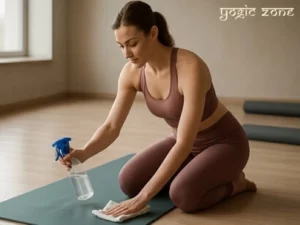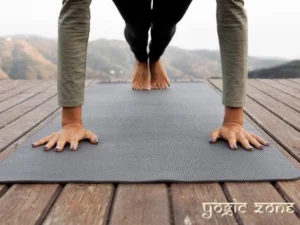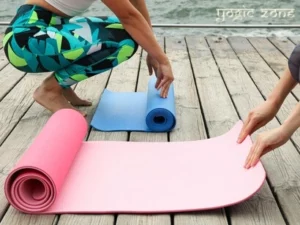
Certified yoga teacher with a 900-hour advanced teachers training | Diploma in Yoga from Mumbai University | Individual and group yoga trainer, therapist, counsellor, and meditation coach. Know more about Chintan Mehta.
Yoga mat thickness is one of the most important features of the yoga mat. It affects our joints, comfort, and balance. With so many options, choosing the right thickness can be difficult. The right yoga mat thickness depends on your body, age, and practice style. My yoga mat thickness guide explains how yoga mat cushioning affects your yoga experience and helps you choose the best option for your personal needs.
| Thickness | Best For | Pros | Cons | |
|---|---|---|---|---|
| 1 | 1–3mm (Thin Mats) | Travel, layering over studio mats, experienced yogis | Ultra-portable, hygienic layer, strong ground connection | Minimal cushioning, not ideal for joint support |
| 2 | 4–5mm (Standard) | Beginners, all-around practice, lean/athletic builds | Balanced cushioning and stability, versatile for most styles | May feel firm on hard floors for sensitive joints |
| 3 | 6–8mm (Thick Mats) | Seniors, joint-sensitive users, heavier body types | Excellent joint support, soft feel, ideal for restorative/home practice | Bulkier, less portable, may reduce balance in standing poses |
| 4 | 8-10mm (Extra Thick Mats) | Sensitive joints, pregnancy back pain relief | Prenatal yoga, and beginners seeking comfort | Reduced ground feel and stability |
How Thick Should My Yoga Mat Be?
For most people, a yoga mat thickness of 4–6 mm offers a good balance of comfort and stability. If you have sensitive joints or practice restorative yoga, consider a thicker mat around 8 mm for extra cushioning.
Choosing the right mat thickness is about balancing comfort with control. A mat’s thickness directly influences joint protection, stability in poses, portability, and durability.
A thick yoga mat for joint support is necessary, especially for sensitive areas like your knees, wrists, and spine during poses. This is an important consideration for anyone with pre-existing joint problems or discomfort.
Yoga Mat Thickness Categories Explained
1–3 mm Yoga Mats
These thin mats are designed for portability. They are lightweight and can be folded or rolled tightly. While they offer minimal cushioning, they are perfect for spreading over a yoga studio’s common mat for hygiene or for use by experienced yogis who want a stronger feel of the ground.
4–5 mm Yoga Mats
This is a good yoga mat thickness and the most common thickness available. It strikes a good balance between yoga mat cushioning and stability, making it an excellent all-around choice for various yoga styles.
6–8 mm Yoga Mats
Mats in this thickness provide significant comfort and joint support. They are ideal for restorative yoga and anyone who prefers softness. A thicker mat is a fantastic choice for home practice on hard floors.
8–10 mm Yoga Mats
This thickness offers extra cushioning for sensitive joints, making them ideal for prenatal yoga, restorative flows, and beginners seeking comfort. While they may reduce ground feel and stability in balance asanas, they’re a popular choice for pregnancy back pain relief.
Do you have any doubts or questions about this article?? Chintan Mehta, the author, would love to hear from you. Send us your question now!
Good Yoga Mat Thickness by Body Type and Practice
1. A Yoga Mat for Beginners & All-Around Practitioners
If you’re just starting out and don’t have specific needs, a standard 4mm mat is a good yoga mat thickness and an ideal starting point. It offers enough support without sacrificing balance. Read my blog on What to Look for in a Yoga Mat for more information.
2. A Yoga Mat for Seniors or Joint-Sensitive Practitioners
For those who need maximum support, or as a yoga mat for seniors, selecting an 8 mm yoga mat thickness or higher thickness is essential. The extra cushion reduces pressure on sensitive joints, making your practice more comfortable and enjoyable. Look for mats with a good anti-slip surface for added safety.
3. A Yoga Mat for a Lean or Athletic Build
Athletes and those with a leaner build often prefer a 4-5 mm yoga mat thickness. The ground feel is important for stability and for maintaining balance in challenging poses.
4. A Yoga Mat for Heavier Body Types
If you have a heavier body type, choosing a 6 mm+ yoga mat thickness is recommended. The extra thickness helps distribute weight and reduce pressure on your joints. Look for a mat made from high-density rubber or foam so that it does not compress too much under pressure.
Your yoga mat should feel like an extension of your body. Whether you need extra yoga mat comfort or prefer ground connection, yoga mat thickness plays a key role in making your practice feel good. The most important lesson from my yoga mat thickness guide is selection based on your body type, not just what’s popular or your budget.
Do you have any doubts or questions about this article?? Chintan Mehta, the author, would love to hear from you. Send us your question now!
Frequently Asked Questions About Yoga Mat Thickness
What is the best thickness for a yoga mat if I’m a beginner?
A 6 mm (¼ inch) mat is generally best for beginners. It provides enough cushioning for comfort while still keeping you stable during standing and balancing poses.
Should I use a 4 mm or 6 mm yoga mat for everyday practice?
If you want a balance of comfort and stability, go for 6 mm. If you prefer a more grounded, stable feel—especially for balancing poses—4 mm may be better.
What thickness of yoga mat is best for hot yoga or sweaty sessions?
For hot yoga, a 3 mm–5 mm mat with a strong grip works well. The priority here is non-slip texture, not thickness, since sweat can make thicker mats feel unstable.
How does yoga mat thickness affect comfort and stability?
Thicker mats = more comfort, less stability.
Thinner mats = more stability, less cushioning.
The right choice depends on what your body needs and the type of yoga you practice.Is an 8 mm or 10 mm mat too thick for regular yoga practice?
For most styles of yoga, yes, 8 mm–10 mm can feel too cushioned and unstable. These mats are better for Pilates, restorative practices, or people with joint concerns.



